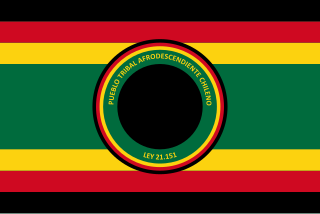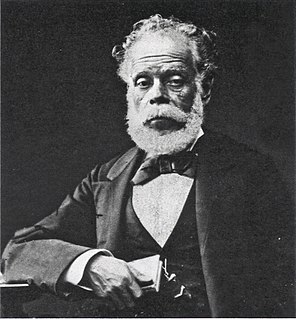
Salsa music is a popular style of Latin American music originated in Santiago de Cuba. With its origin roots primarily based on Cuban son montuno, with elements of Cuban rhythms such as mambo, Latin jazz, and Son. All of these elements are adapted to fit the basic son montuno template when performed within the context of salsa.

In the Quechua, Aymara, and Inca mythologies, Supay was both the god of death and ruler of the Ukhu Pacha, the Incan underworld, as well as a race of demons. Supay is associated with miners' rituals.
The Music of Peru is an amalgamation of sounds and styles drawing on Peru's Andean, Spanish, and African roots. Andean influences can perhaps be best heard in wind instruments and the shape of the melodies, while the African influences can be heard in the rhythm and percussion instruments, and European influences can be heard in the harmonies and stringed instruments. Pre-Columbian Andean music was played on drums and string instruments, like the European pipe and tabor tradition. Andean tritonic and pentatonic scales were elaborated during the colonial period into hexatonic, and in some cases, diatonic scales.
Afro-Peruvian music, or Música negra, is a type of Latin American music first developed in Peru by enslaved black people from West Africa, where it is known as música criolla. The genre is a mix of West African and Spanish music.
Música criolla or canción criolla is a varied genre of Peruvian music that exhibits influences from European, African and Andean music. The genre's name reflects the coastal culture of Peru, and the local evolution of the term criollo, a word originally denoting high-status people of full Spanish ancestry, into a more socially inclusive element of the nation.
Landó is an Afro-Peruvian form of music in the musica criolla genre.

Black Peruvians or Afro-Peruvians are Peruvian citizens of African descent. They mostly descend from enslaved Africans brought to Peru after the arrival of the conquistadors.

The Carnival of Oruro is a religious and cultural festival in Oruro, Bolivia. It has been celebrated since the 18th century. Originally an indigenous festival, the celebration later was transformed to incorporate a Christian ritual around the Virgin of Candelaria . The carnival is one of UNESCO's Masterpieces of the Oral and Intangible Heritage of Humanity.

Dance in Peru is an art form primarily of native origin. There are also dances that are related to agricultural work, hunting and war. In Peru dancing bears an important cultural significance. Some choreographies show certain Christian influence.
Festejo is a festive form of Afro-Peruvian music. The dance is a staple in the Black coastal populations and it celebrates the emancipation of slaves. Festejo is recognized for its high energy and the improvisation carried out by the dancers. Some believe that its origins trace back to competitive dance circles performed by individuals playing cajóns. Despite its African origins, people of all different backgrounds participate in the dance that many regards as one of the greatest representations of Peruvian culture.

Afro-Peruvian Classics: The Soul of Black Peru is a 1995 album. The album was compiled by David Byrne, and was one of the first international releases of Afro-Peruvian music.
The vals criollo, or Peruvian waltz, is an adaptation of the European waltz brought to the Americas during colonial times by Spain. In the Viceroyalty of Peru, the waltz was gradually adapted to the likings of the Criollo people. In the 20th century, the genre became symbolic of the nation's culture as it gained widespread popularity in the country.

Nicomedes Santa Cruz Gamarra was a Peruvian singer, songwriter and musicologist. He was primarily a decimista, a singer of décimas. He researched most forms of Afro-Peruvian music and dance, becoming the leading ethnomusicologist in Peru.

Afro-Chileans are descendants of slaves who were brought to the Americas via the trans-Atlantic slave trade to Chile and recent migrants from the Caribbean, Latin America, and Africa. Afro-Chileans continue to face erasure & discrimination within modern Chilean society.

The Diablada, also known as the Danza de los Diablos, is an Andean folk dance performed in the Altiplano region of South America, characterized by performers wearing masks and costumes representing the devil and other characters from pre-Columbian theology and mythology. combined with Spanish and Christian elements added during the colonial era. Many scholars have concluded that the dance is descended from the Llama llama dance in honor of the Uru god Tiw, and the Aymaran ritual to the demon Anchanchu, both originating in pre-Columbian Bolivia, though there are competing theories on the dance's origins.

Afro-Venezuelans are Venezuelans of African descent. They are mostly descendants of enslaved Africans brought to the Western Hemisphere during the Atlantic slave trade. This term also sometimes refers to the combining of African and other cultural elements found in Venezuelan society such as the arts, traditions, music, religion, race, and language.

Bolivians are people identified with the country of Bolivia. This connection may be residential, legal, historical or cultural. For most Bolivians, several of these connections exist and are collectively the source of their being Bolivian.

Francisco Fierro Palas, called "Pancho" Fierro was a Peruvian painter, known primarily for his costumbrista watercolors, which depict his country's life and customs.

Victoria Eugenia Santa Cruz Gamarra was an Afro-Peruvian choreographer, composer, and activist.












